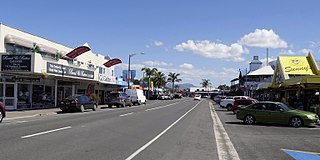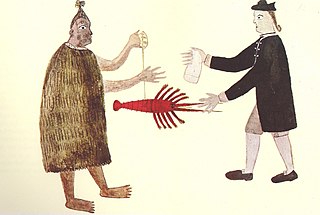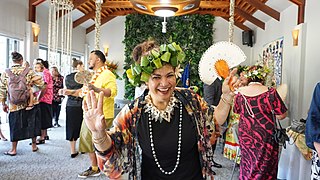
The Cook Islands is a self-governing island country in the South Pacific Ocean in free association with New Zealand. It comprises 15 islands whose total land area is 236.7 square kilometres (91 sq mi). The Cook Islands' Exclusive Economic Zone (EEZ) covers 1,960,027 square kilometres (756,771 sq mi) of ocean.

The demographics of New Zealand encompass the gender, ethnic, religious, geographic, and economic backgrounds of the 5.1 million people living in New Zealand. New Zealanders predominantly live in urban areas on the North Island. The five largest cities are Auckland, Wellington, Christchurch, Hamilton, and Tauranga. Few New Zealanders live on New Zealand's smaller islands. Waiheke Island is easily the most populated smaller island with 9,420 residents, while Great Barrier Island, the Chatham and Pitt Islands, and Stewart Island each have populations below 1,000. New Zealand is part of a realm and most people born in the realm's external territories of Tokelau, the Ross Dependency, the Cook Islands and Niue are entitled to New Zealand passports.

The New Zealand Census of Population and Dwellings is a national population and housing census conducted by government department Statistics New Zealand every five years. There have been 34 censuses since 1851. In addition to providing detailed information about national demographics, the results of the census play an important part in the calculation of resource allocation to local service providers.

Tolaga Bay is both a bay and small town on the East Coast of New Zealand's North Island located 45 kilometres northeast of Gisborne and 30 kilometres south of Tokomaru Bay.

Whitianga is a town on the Coromandel Peninsula, in the Waikato region of New Zealand's North Island. The town is located on Mercury Bay, on the northeastern coast of the peninsula. The town has a permanent population of 6,440 as of June 2023, making it the second-largest town on the Coromandel Peninsula behind Thames.

New Zealanders, colloquially known as Kiwis, are people associated with New Zealand, sharing a common history, culture, and language. People of various ethnicities and national origins are citizens of New Zealand, governed by its nationality law.
Waharoa is a rural community in the Waikato region of New Zealand's North Island. It is located 7 km north of Matamata, and is part of the Matamata-Piako District. It is located at the junction of the Kinleith Branch railway and the East Coast Main Trunk Railway. State Highway 27 runs through the town, which is serviced by several shops and cafes and by a petrol station. Matamata Airport is just over 3 km (1.9 mi) north of Waharoa.
New Zealanders of European descent are mostly of British and Irish ancestry, with significantly smaller percentages of other European ancestries such as Germans, Poles, French, Dutch, Croats and other South Slavs, Greeks, and Scandinavians. European New Zealanders are also known by the Māori-language loanword Pākehā.

Mount Cook is an inner suburb of the metropolitan area of Wellington, The North Island, New Zealand, 1.74 km dead south of Wellington's Central Business District. Its local constituency area is the Wellington Central, and is part of the City of Wellington local government area. The suburb stands on the southern fringe of the central city alongside Te Aro and to the north of Newtown.

New Zealand is an island country in the southwestern Pacific Ocean. It consists of two main landmasses—the North Island and the South Island —and over 700 smaller islands. It is the sixth-largest island country by area and lies east of Australia across the Tasman Sea and south of the islands of New Caledonia, Fiji, and Tonga. The country's varied topography and sharp mountain peaks, including the Southern Alps, owe much to tectonic uplift and volcanic eruptions. New Zealand's capital city is Wellington, and its most populous city is Auckland.
Statistics Canada conducts a national census of population and census of agriculture every five years and releases the data with a two-year lag.

Religion in New Zealand encompasses a wide range of groups and beliefs. New Zealand has no state religion or established church and freedom of religion has been protected since the signing of the Treaty of Waitangi.

Portland is a locality on the western side of Whangarei Harbour in Northland, New Zealand. Whangarei is about 10 km to the north. Tikorangi is a hill to the west with a summit 161 m above sea level.

Cook Islanders are residents of the Cook Islands, which is composed of 15 islands and atolls in Polynesia in the Pacific Ocean. Cook Islands Māori are the indigenous Polynesian people of the Cook Islands, although more Cook Islands Māori currently reside in New Zealand than the Cook Islands. Originating from Tahitian settlers in the sixth century, the Cook Islands Māori bear cultural affinities with New Zealand Māori and Tahitian Mā'ohi, although they also exhibit a unique culture and developed their own language, which is currently recognized as one of two official languages in the Cook Islands, according to the Te Reo Maori Act of 2003.

Māori are the indigenous Polynesian people of mainland New Zealand. Māori originated with settlers from East Polynesia, who arrived in New Zealand in several waves of canoe voyages between roughly 1320 and 1350. Over several centuries in isolation, these settlers developed their own distinctive culture, whose language, mythology, crafts, and performing arts evolved independently from those of other eastern Polynesian cultures. Some early Māori moved to the Chatham Islands, where their descendants became New Zealand's other indigenous Polynesian ethnic group, the Moriori.

Walton is a settlement in New Zealand. It is sited at the junction of Walton Road and Morrinsville Walton Road, in the Central Waikato Region.
The 1911 New Zealand census was New Zealand's fifteenth national census. The day used for the census was Sunday, 2 April 1911.

The history of the Māori began with the arrival of Polynesian settlers in New Zealand, in a series of ocean migrations in canoes starting from the late 13th or early 14th centuries. Over several centuries of isolation, the Polynesian settlers formed a distinct culture that became known as the Māori.

Pasifika New Zealanders are a pan-ethnic group of New Zealanders associated with, and descended from, the indigenous peoples of the Pacific Islands outside of New Zealand itself. They form the fourth-largest ethnic grouping in the country, after European descendants, indigenous Māori, and Asian New Zealanders. There are over 380,000 Pasifika people in New Zealand, with the majority living in Auckland. 8% of the population of New Zealand identifies as being of Pacific origin.













